Haoyu Yang
EAROL: Environmental Augmented Perception-Aware Planning and Robust Odometry via Downward-Mounted Tilted LiDAR
Aug 20, 2025Abstract:To address the challenges of localization drift and perception-planning coupling in unmanned aerial vehicles (UAVs) operating in open-top scenarios (e.g., collapsed buildings, roofless mazes), this paper proposes EAROL, a novel framework with a downward-mounted tilted LiDAR configuration (20{\deg} inclination), integrating a LiDAR-Inertial Odometry (LIO) system and a hierarchical trajectory-yaw optimization algorithm. The hardware innovation enables constraint enhancement via dense ground point cloud acquisition and forward environmental awareness for dynamic obstacle detection. A tightly-coupled LIO system, empowered by an Iterative Error-State Kalman Filter (IESKF) with dynamic motion compensation, achieves high level 6-DoF localization accuracy in feature-sparse environments. The planner, augmented by environment, balancing environmental exploration, target tracking precision, and energy efficiency. Physical experiments demonstrate 81% tracking error reduction, 22% improvement in perceptual coverage, and near-zero vertical drift across indoor maze and 60-meter-scale outdoor scenarios. This work proposes a hardware-algorithm co-design paradigm, offering a robust solution for UAV autonomy in post-disaster search and rescue missions. We will release our software and hardware as an open-source package for the community. Video: https://youtu.be/7av2ueLSiYw.
GLM-4.5: Agentic, Reasoning, and Coding (ARC) Foundation Models
Aug 08, 2025Abstract:We present GLM-4.5, an open-source Mixture-of-Experts (MoE) large language model with 355B total parameters and 32B activated parameters, featuring a hybrid reasoning method that supports both thinking and direct response modes. Through multi-stage training on 23T tokens and comprehensive post-training with expert model iteration and reinforcement learning, GLM-4.5 achieves strong performance across agentic, reasoning, and coding (ARC) tasks, scoring 70.1% on TAU-Bench, 91.0% on AIME 24, and 64.2% on SWE-bench Verified. With much fewer parameters than several competitors, GLM-4.5 ranks 3rd overall among all evaluated models and 2nd on agentic benchmarks. We release both GLM-4.5 (355B parameters) and a compact version, GLM-4.5-Air (106B parameters), to advance research in reasoning and agentic AI systems. Code, models, and more information are available at https://github.com/zai-org/GLM-4.5.
TK-Mamba: Marrying KAN with Mamba for Text-Driven 3D Medical Image Segmentation
May 24, 2025



Abstract:3D medical image segmentation is vital for clinical diagnosis and treatment but is challenged by high-dimensional data and complex spatial dependencies. Traditional single-modality networks, such as CNNs and Transformers, are often limited by computational inefficiency and constrained contextual modeling in 3D settings. We introduce a novel multimodal framework that leverages Mamba and Kolmogorov-Arnold Networks (KAN) as an efficient backbone for long-sequence modeling. Our approach features three key innovations: First, an EGSC (Enhanced Gated Spatial Convolution) module captures spatial information when unfolding 3D images into 1D sequences. Second, we extend Group-Rational KAN (GR-KAN), a Kolmogorov-Arnold Networks variant with rational basis functions, into 3D-Group-Rational KAN (3D-GR-KAN) for 3D medical imaging - its first application in this domain - enabling superior feature representation tailored to volumetric data. Third, a dual-branch text-driven strategy leverages CLIP's text embeddings: one branch swaps one-hot labels for semantic vectors to preserve inter-organ semantic relationships, while the other aligns images with detailed organ descriptions to enhance semantic alignment. Experiments on the Medical Segmentation Decathlon (MSD) and KiTS23 datasets show our method achieving state-of-the-art performance, surpassing existing approaches in accuracy and efficiency. This work highlights the power of combining advanced sequence modeling, extended network architectures, and vision-language synergy to push forward 3D medical image segmentation, delivering a scalable solution for clinical use. The source code is openly available at https://github.com/yhy-whu/TK-Mamba.
Hunyuan-Game: Industrial-grade Intelligent Game Creation Model
May 20, 2025Abstract:Intelligent game creation represents a transformative advancement in game development, utilizing generative artificial intelligence to dynamically generate and enhance game content. Despite notable progress in generative models, the comprehensive synthesis of high-quality game assets, including both images and videos, remains a challenging frontier. To create high-fidelity game content that simultaneously aligns with player preferences and significantly boosts designer efficiency, we present Hunyuan-Game, an innovative project designed to revolutionize intelligent game production. Hunyuan-Game encompasses two primary branches: image generation and video generation. The image generation component is built upon a vast dataset comprising billions of game images, leading to the development of a group of customized image generation models tailored for game scenarios: (1) General Text-to-Image Generation. (2) Game Visual Effects Generation, involving text-to-effect and reference image-based game visual effect generation. (3) Transparent Image Generation for characters, scenes, and game visual effects. (4) Game Character Generation based on sketches, black-and-white images, and white models. The video generation component is built upon a comprehensive dataset of millions of game and anime videos, leading to the development of five core algorithmic models, each targeting critical pain points in game development and having robust adaptation to diverse game video scenarios: (1) Image-to-Video Generation. (2) 360 A/T Pose Avatar Video Synthesis. (3) Dynamic Illustration Generation. (4) Generative Video Super-Resolution. (5) Interactive Game Video Generation. These image and video generation models not only exhibit high-level aesthetic expression but also deeply integrate domain-specific knowledge, establishing a systematic understanding of diverse game and anime art styles.
Deep Physics Prior for First Order Inverse Optimization
Apr 28, 2025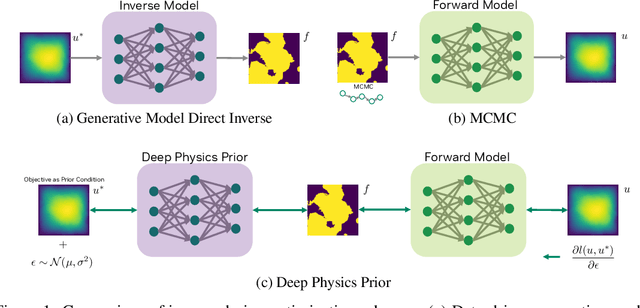


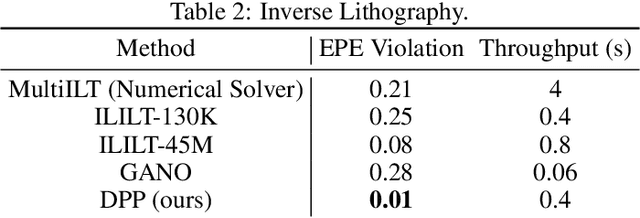
Abstract:Inverse design optimization aims to infer system parameters from observed solutions, posing critical challenges across domains such as semiconductor manufacturing, structural engineering, materials science, and fluid dynamics. The lack of explicit mathematical representations in many systems complicates this process and makes the first order optimization impossible. Mainstream approaches, including generative AI and Bayesian optimization, address these challenges but have limitations. Generative AI is computationally expensive, while Bayesian optimization, relying on surrogate models, suffers from scalability, sensitivity to priors, and noise issues, often leading to suboptimal solutions. This paper introduces Deep Physics Prior (DPP), a novel method enabling first-order gradient-based inverse optimization with surrogate machine learning models. By leveraging pretrained auxiliary Neural Operators, DPP enforces prior distribution constraints to ensure robust and meaningful solutions. This approach is particularly effective when prior data and observation distributions are unknown.
MAPS: Multi-Fidelity AI-Augmented Photonic Simulation and Inverse Design Infrastructure
Mar 02, 2025



Abstract:Inverse design has emerged as a transformative approach for photonic device optimization, enabling the exploration of high-dimensional, non-intuitive design spaces to create ultra-compact devices and advance photonic integrated circuits (PICs) in computing and interconnects. However, practical challenges, such as suboptimal device performance, limited manufacturability, high sensitivity to variations, computational inefficiency, and lack of interpretability, have hindered its adoption in commercial hardware. Recent advancements in AI-assisted photonic simulation and design offer transformative potential, accelerating simulations and design generation by orders of magnitude over traditional numerical methods. Despite these breakthroughs, the lack of an open-source, standardized infrastructure and evaluation benchmark limits accessibility and cross-disciplinary collaboration. To address this, we introduce MAPS, a multi-fidelity AI-augmented photonic simulation and inverse design infrastructure designed to bridge this gap. MAPS features three synergistic components: (1) MAPS-Data: A dataset acquisition framework for generating multi-fidelity, richly labeled devices, providing high-quality data for AI-for-optics research. (2) MAPS-Train: A flexible AI-for-photonics training framework offering a hierarchical data loading pipeline, customizable model construction, support for data- and physics-driven losses, and comprehensive evaluations. (3) MAPS-InvDes: An advanced adjoint inverse design toolkit that abstracts complex physics but exposes flexible optimization steps, integrates pre-trained AI models, and incorporates fabrication variation models. This infrastructure MAPS provides a unified, open-source platform for developing, benchmarking, and advancing AI-assisted photonic design workflows, accelerating innovation in photonic hardware optimization and scientific machine learning.
SUPERMERGE: An Approach For Gradient-Based Model Merging
Dec 09, 2024Abstract:Large language models, such as ChatGPT, Claude, or LLaMA, are gigantic, monolithic, and possess the superpower to simultaneously support thousands of tasks. However, high-throughput applications often prefer smaller task-specific models because of their lower latency and cost. One challenge of using task-specific models is the incremental need for solving newer tasks after the model is already deployed for existing tasks. A straightforward solution requires fine-tuning the model again for both existing and new tasks, which is computationally expensive and time-consuming. To address this issue, we propose a model merging based approach called SUPERMERGE. SUPERMERGE is a gradient-based method to systematically merge several fine-tuned models trained on existing and new tasks. SUPERMERGE is designed to be lightweight and fast, and the merged model achieves similar performance to fully fine-tuned models on all tasks. Furthermore, we proposed a hierarchical model merging strategy to reduce the peak space requirement without sacrificing the performance of the merged model. We experimentally demonstrate that SUPERMERGE outperforms existing model merging methods on common natural language processing and computer vision tasks.
GPU-Accelerated Inverse Lithography Towards High Quality Curvy Mask Generation
Nov 11, 2024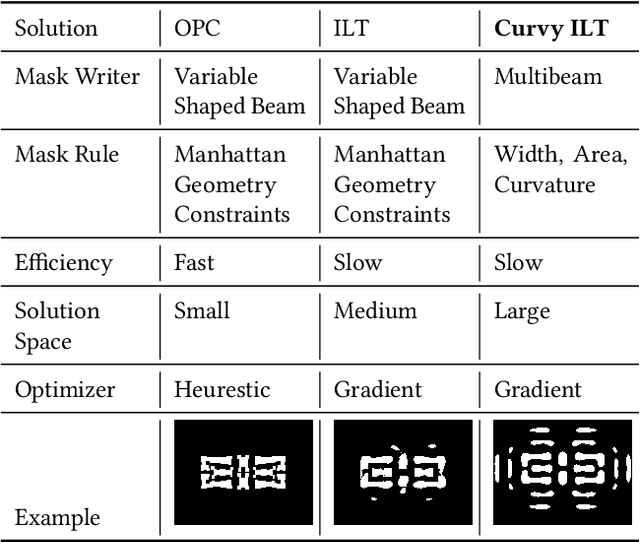

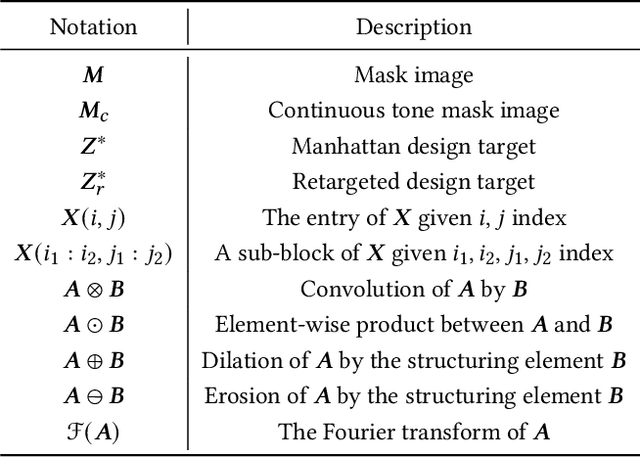
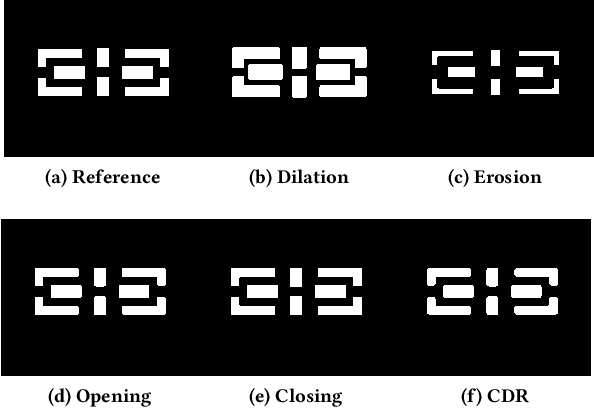
Abstract:Inverse Lithography Technology (ILT) has emerged as a promising solution for photo mask design and optimization. Relying on multi-beam mask writers, ILT enables the creation of free-form curvilinear mask shapes that enhance printed wafer image quality and process window. However, a major challenge in implementing curvilinear ILT for large-scale production is mask rule checking, an area currently under development by foundries and EDA vendors. Although recent research has incorporated mask complexity into the optimization process, much of it focuses on reducing e-beam shots, which does not align with the goals of curvilinear ILT. In this paper, we introduce a GPU-accelerated ILT algorithm that improves not only contour quality and process window but also the precision of curvilinear mask shapes. Our experiments on open benchmarks demonstrate a significant advantage of our algorithm over leading academic ILT engines.
Intelligent OPC Engineer Assistant for Semiconductor Manufacturing
Aug 27, 2024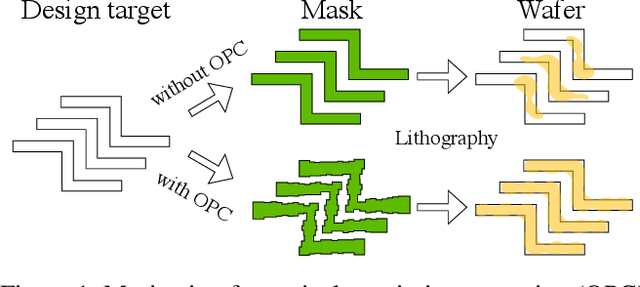
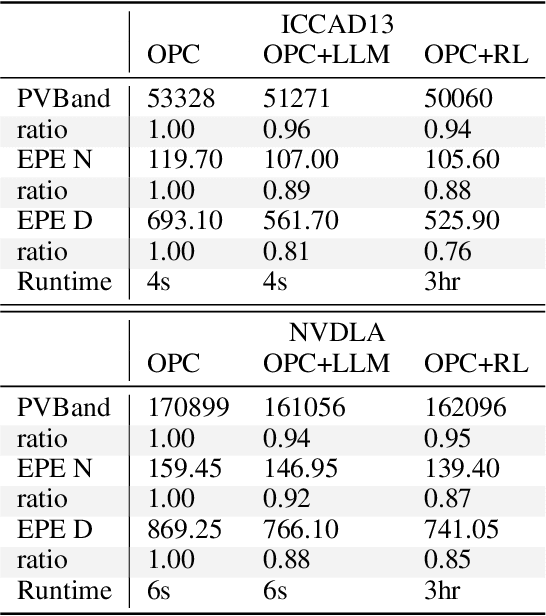
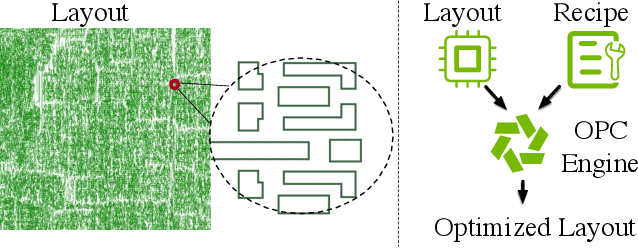
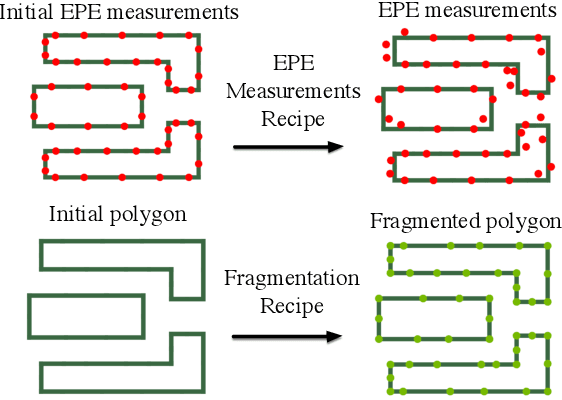
Abstract:Advancements in chip design and manufacturing have enabled the processing of complex tasks such as deep learning and natural language processing, paving the way for the development of artificial general intelligence (AGI). AI, on the other hand, can be leveraged to innovate and streamline semiconductor technology from planning and implementation to manufacturing. In this paper, we present \textit{Intelligent OPC Engineer Assistant}, an AI/LLM-powered methodology designed to solve the core manufacturing-aware optimization problem known as optical proximity correction (OPC). The methodology involves a reinforcement learning-based OPC recipe search and a customized multi-modal agent system for recipe summarization. Experiments demonstrate that our methodology can efficiently build OPC recipes on various chip designs with specially handled design topologies, a task that typically requires the full-time effort of OPC engineers with years of experience.
Differentiable Edge-based OPC
Aug 16, 2024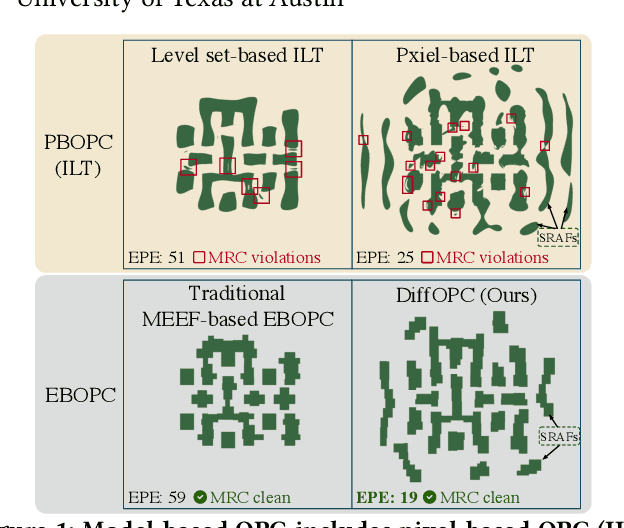

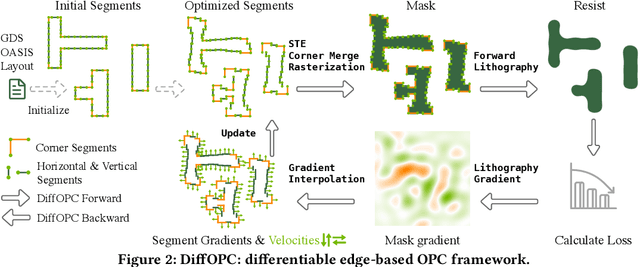

Abstract:Optical proximity correction (OPC) is crucial for pushing the boundaries of semiconductor manufacturing and enabling the continued scaling of integrated circuits. While pixel-based OPC, termed as inverse lithography technology (ILT), has gained research interest due to its flexibility and precision. Its complexity and intricate features can lead to challenges in mask writing, increased defects, and higher costs, hence hindering widespread industrial adoption. In this paper, we propose DiffOPC, a differentiable OPC framework that enjoys the virtue of both edge-based OPC and ILT. By employing a mask rule-aware gradient-based optimization approach, DiffOPC efficiently guides mask edge segment movement during mask optimization, minimizing wafer error by propagating true gradients from the cost function back to the mask edges. Our approach achieves lower edge placement error while reducing manufacturing cost by half compared to state-of-the-art OPC techniques, bridging the gap between the high accuracy of pixel-based OPC and the practicality required for industrial adoption, thus offering a promising solution for advanced semiconductor manufacturing.
 Add to Chrome
Add to Chrome Add to Firefox
Add to Firefox Add to Edge
Add to Edge